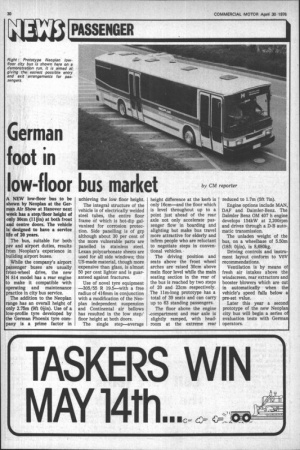German foot in low-floor bus market
Page 32

If you've noticed an error in this article please click here to report it so we can fix it.
by CM reporter A NEW low-floor bus to be shown by Neoplan at the German Air Show at Hanover next week has a step/floor height of only 30cm (11fin) at both front and centre doors. The vehicle is designed to have a service life of 20 years.
The bus, suitable for both psv and airport duties, results from Neoplan's experience in building airport buses.
While the company's airport passenger buses are usually front-wheel drive, the new N 814 model has a rear engine to make it compatible with operating and maintenance practice in city bus service.
The addition to the Neoplan range has an overall height of only 2.75m (9ft Olin). Use of a low-profile tyre developed by the German Phoenix tyre company is a prime factor in achieving the low floor height.
The integral structure of the vehicle is of electrically welded steel tubes, the entire floor frame of which is hot-dip galvanised for corrosion protection. Side panelling is of grp although about 30 per cent of the more vulnerable parts are panelled in stainless steel. Lexan polycarbonate sheets are used for all side windows; this US-made material, though more expensive than glass, is almost 50 per cent lighter and is guaranteed against fractures.
Use of novel tyre equipment —305/55 R 19.5—with a free radius of 416mm in conjunction with a modification of the Neoplan independent suspension and Continental air bellows has resulted in the low step/ floor height at both doors.
The single step—average height difference at the kerb is only 16cm—and the floor which is level throughout up to a point just ahead of the rear axle not only accelerate passenger flow in boarding and alighting but make bus travel more attractive for elderly and infirm people who are reluctant to negotiate steps in conventional vehicles.
The driving position and seats above the front wheel arches are raised 30cm above main floor level while the main seating section in the rear of the bus is reached by two steps of 20 and 22cm respectively. The I lm-long prototype has a total of 39 seats and can carry up to 63 standing passengers.
The floor above the engine -compartment and rear axle is slightly ramped, with headroom at the extreme rear reduced to 1.7m (5ft 7th).
Engine options include MAN, DAF and Daimler-Benz. The Daimler Benz OM 407 h engine develops 154kW at 2,200rpm and drives through a D-B automatic transmission.
The unladen weight of the bus, on a wheelbase of 5.50m (18ft Olin), is 8,680kg.
Driving controls and instrument layout conform to VW recommendations.
Ventilation is by means of fresh air intakes above the windscreen, rear extractors and booster blowers which are cut in automatically when the vehicle's speed falls below a pre-set value.
Later this year a second prototype of the new Neoplan city bus will begin a series of evaluation tests with German operators.
















































































































































